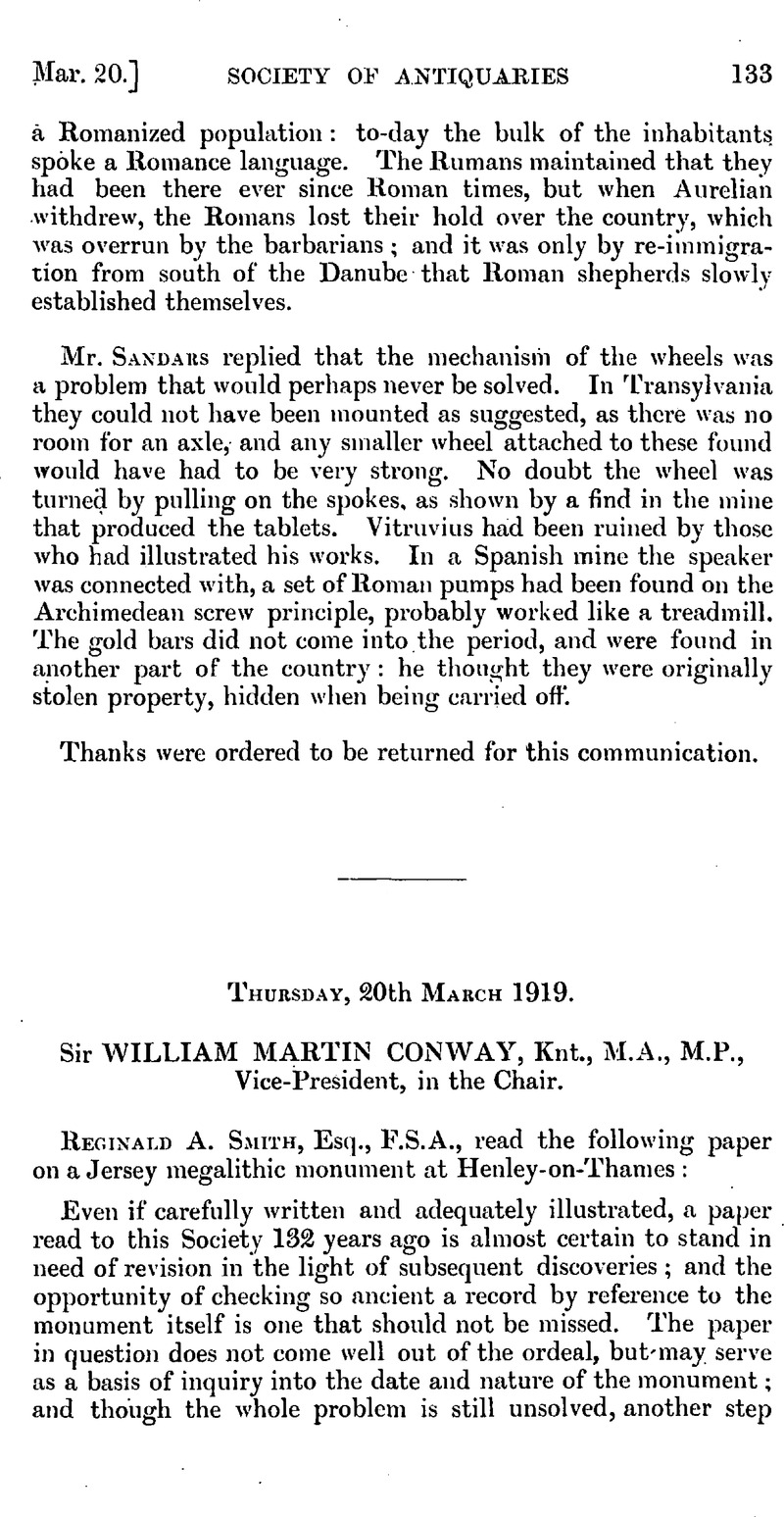Published online by Cambridge University Press: 10 May 2010

page 134 note 1 These really belong to Marshal Conway's letter, printed after Mr. Molesworth's account in Archaeologia, but adding no information of any importance.
page 135 note 1 As re-erected at Henley the passage points north of east, and the interior diameter of the circle is 27 ft.
page 135 note 2 Fergusson says there were originally seven cells (see below).
page 135 note 3 This gives a diameter of 23 ft. The present inside measurement is 27 ft.
page 135 note 4 This word is now generally used for stone-circles : dolmens are here meant.
page 136 note 1 If a circle may be assumed, the diameter would be 40½ ft.
page 136 note 2 Journ. Ethnol. Soc, ii, 65, in a paper on megaliths of the Channel Islands. Guernsey monuments are described in Archaeologia, xvii.
page 137 note 1 Rude Stone Monuments, p. 51.
page 139 note 1 Montelius, Der Orient und Europa, 134.
page 140 note 1 T. E. Peet, Rough Stone Monuments, 106.
page 140 note 2 Journ. Brit. Arch. Assoc, i, 27 (F. C. Lukis).
page 140 note 3 M. J. Walhouse on non-sepulchral rude stone monuments (Journ. Anthrop. Inst., vii (1878), p. 30).
page 140 note 4 Journ. It. Anthrop. Inst., xxxix, 521 (Lough Gur).
page 142 note 1 Disturbance in Roman times has been also noticed in Brittany (Matériaux pour l'histoire dr. l'homme, xiv (1879), 146, pl. v)Google Scholar; at Wick Barrow, Stogursey, Som. (H. St. G. Gray, Excavations at Wick Barrow, pp. 21, 32, 61); and at West Kennet long-barrow, Wilts. (Archaeologia, xxxviii, 411).
page 143 note 1 Montelius, Der Orient and Europa, 61.
page 143 note 2 References in T. R. Holmes's Ancient Britain, 102.
page 143 note 3 Fornier, ‘Enceintes gauloises, lie la Ville-Pichard en Pléneuf’, in Bulletins et Mémoires de la Société d' Émulation dex Côtes-du-Nord (St. Brieuc, 1887) xxv, 250.
page 144 note 1 W. C. Lukis, Prehistoric Stone Monuments of the British Isles (Cornwall), plates xxxv and xxxix.
page 144 note 2 Journ. Brit. Arch. Assoc, xviii, 117, and pl. vii.
page 144 note 3 Louis Siret, Chronologie et ethnographie ibériques, i, 135:
page 147 note 1 Proceedings, xxi, 469.
page 147 note 2 Archaeologia, xvi, pl. lxx ; the hoard is in the National Collection.
page 147 note 3 Home Ferules, p. 167., fig. 1.
page 149 note 1 Alterthümer urns, heid. Vorzeit, v. 397; vol. i, 11, 1, figs. 4, 5 ; vol. iii, 7, 2, figs. 1–3.
page 149 note 2 Proc. R. Irish Academy, xxvii, c (1909); pl. xiv., reproducing the Bingen, Magdeburg, and Halland specimens from Lindenschmit, as well as one of alder-wood from co. Leitrim.
page 149 note 3 For other references see W. J. Hemp, F.S. A., in Proceedings, xxx. 167.
page 149 note 4 Bronze Implements, pp. 343–56.
page 150 note 1 J. C. Bruce, Catalogue of Alnwick Castle Museum, p. 63, no. 270, pl. xvii a, fig. 2.
page 150 note 2 Bruce, op. cit., p. 62, nos. 268, 269, pl. xvii a, fig. 3, and restoration on p. 64.
page 150 note 3 Our Fellow Mr. Alexander Curie kindly informs me that the illustration of this shield in Cat. Nat. Mus. Edinb., p. 149 (Evans, Bronze, fig. 435) is inaccurate. It has 24 ribs, and the second 30. A third (now apparently lost) is described in Proc. Soc. Ant. Scot., v, 393.
page 151 note 1 Besides those from rivers, shields from the following sites were found in peat or marshy ground : Harlech, Beith, Yetholm, Aberystwyth, Moel Siabod, Ingoe (two), Coveney, and Ballynamona.
page 156 note 1 Another from Castropol is in the British Museum (Greenwell Collection).
page 157 note 1 Compte rendu, Monaco Congress (1906), ii, 78.
page 158 note 1 Baron de Baye, Notes sur l'époque des métauce en Ukraine (pp. 1 and 374). The bronze specimen from Kertch, engraved with a horned animal (Archaeologia, lviii, 12, fig. 13), may also be mentioned in this connexion.
page 158 note 2 Proceedings, xxi, 138 ; Map and list, xxiv, 43, 48.
page 158 note 3 G. Coffey, Bronze Age in Ireland, 27.
page 161 note 1 Brit. Mus. Bronze Age Guide, fig. 119.
page 161 note 2 Bronze Age parallels in Spain and Bohemia are illustrated by Siret, p. 154.